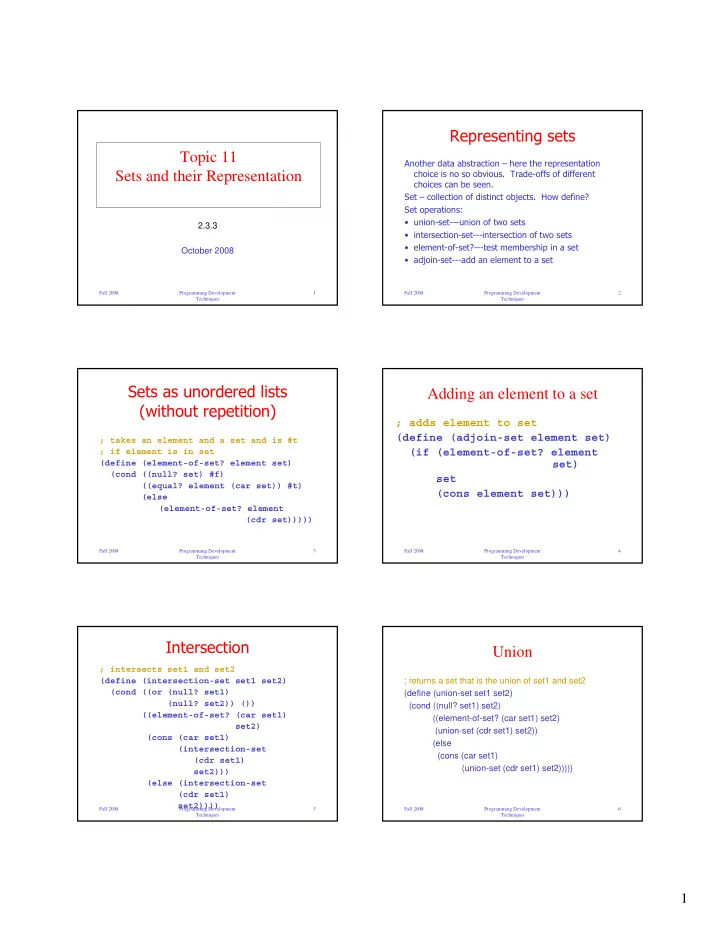

Representing sets Topic 11 Another data abstraction – here the representation choice is no so obvious. Trade-offs of different Sets and their Representation choices can be seen. Set – collection of distinct objects. How define? Set operations: • union-set---union of two sets 2.3.3 • intersection-set---intersection of two sets • element-of-set?---test membership in a set October 2008 • adjoin-set---add an element to a set Fall 2008 Programming Development 1 Fall 2008 Programming Development 2 Techniques Techniques Sets as unordered lists Adding an element to a set (without repetition) ; adds element to set (define (adjoin-set element set) ; takes an element and a set and is #t (if (element-of-set? element ; if element is in set (define (element-of-set? element set) set) (cond ((null? set) #f) set ((equal? element (car set)) #t) (cons element set))) (else (element-of-set? element (cdr set))))) Fall 2008 Programming Development 3 Fall 2008 Programming Development 4 Techniques Techniques Intersection Union ; intersects set1 and set2 (define (intersection-set set1 set2) ; returns a set that is the union of set1 and set2 (cond ((or (null? set1) (define (union-set set1 set2) (null? set2)) ()) (cond ((null? set1) set2) ((element-of-set? (car set1) ((element-of-set? (car set1) set2) set2) (union-set (cdr set1) set2)) (cons (car set1) (else (intersection-set (cons (car set1) (cdr set1) (union-set (cdr set1) set2))))) set2))) (else (intersection-set (cdr set1) set2)))) Fall 2008 Programming Development 5 Fall 2008 Programming Development 6 Techniques Techniques 1
Sets as ordered lists (of Orders of growth for this numbers, ascending order) representation ; Advantage is that now this operation ; can be written more efficiently • element-of-set? --- θ (n) ; returns #t if element is in the • adjoin-set --- θ (n) ; ordered set of numbers • intersection-set --- θ (n 2 ) (define element-of-set? element set) • union-set --- θ (n 2 ) (cond ((null? set) #f) ((= element (car set)) #t) Could speed some of these operations if ((< element (car set)) #f) we change the representation of set. (else (element-of-set? Try a representation where set elements element listed in increasing order. (cdr set))))) Fall 2008 Programming Development 7 Fall 2008 Programming Development 8 Techniques Techniques (continued) intersection-set (bigger speed-up) ; returns an order set that is the ((< (car set1) (car set2)) ; intersection of ordered set1 and set2 (intersection-set (cdr set1) (define (intersection-set set1 set2) set2)) (cond ((or (null? set1) (null? set2)) (else ()) (intersection-set set1 ((= (car set1) (car set2)) (cdr (cons (car set1) set2))))) (intersection-set (cdr set1) (cdr set2)))) Fall 2008 Programming Development 9 Fall 2008 Programming Development 10 Techniques Techniques Orders of growth We can do even better! • All four operations have order of growth equal to θ (n) • Arrange set elements in the form of an ordered binary tree. • Operations element-of-set? and adjoin-set have been speeded up by a factor of 2 Binary tree • Entry – element at that spot • Left subtree – all elements are smaller than entry • Right subtree – all elements are greater than entry Fall 2008 Programming Development 11 Fall 2008 Programming Development 12 Techniques Techniques 2
Notice: more than one representation Sets as (labeled) binary trees for any list ; we can represent binary trees as lists • {1, 2, 4, 5, 6, 8, 10} ; make a tree from an entry and a left ; and right child (define (make-tree entry • (5 (2 (1 () ()) (4 () ())) (8 (6 () ()) (10 () ())) left-child right-child) • (2 (1 () ()) (4 () (8 (6 (5 () ())) () (10 () ())))) (list entry left-child right-child)) • (4 (2 () ()) (6 (5 () ()) (8 () 10) ; selectors for a tree (define (entry tree) (car tree)) • (4 (2 (1 () ())) (5 () (6 () (8 () (10 () ()))))) (define (left-branch tree) (cadr tree)) (define (right-branch tree) (caddr tree)) Fall 2008 Programming Development 13 Fall 2008 Programming Development 14 Techniques Techniques element of set adjoin set ; takes an element and a set represented ; takes an element and a set represented as ; as a binary tree – returns #t if element ; a binary tree. Adds element into the set ; is in set (define (adjoin-set element set) (define (element-of-set? element set) (cond ((null? set) (cond ((null? set) #f) (make-tree element () ())) ((= element (entry set)) #t) ((= element (entry set)) set) ((< element (entry set)) ((< element (entry set)) (element-of-set? element (make-tree (entry set) (left-branch set))) (adjoin-set (else element (element-of-set? (left-branch set)) element (right-branch set))) (right-branch set))))) Fall 2008 Programming Development 15 Fall 2008 Programming Development 16 Techniques Techniques (continued) Properties of tree represention • If the trees are kept balanced, order of growth of (else element-of-set? and adjoin-set is θ (log n) (make-tree (entry set) • Operations intersection-set and union-set (left-branch set) can be implemented to have order of growth (adjoin-set θ (n), but the implementations are complicated element (right-branch set)))))) Fall 2008 Programming Development 17 Fall 2008 Programming Development 18 Techniques Techniques 3
Comparison: orders of growth ( θ ) Operation unordered ordered tree element-of-set? n n log n adjoin-set n n log n intersection-set n 2 n n union-set n 2 n n Fall 2008 Programming Development 19 Techniques 4
Recommend
More recommend